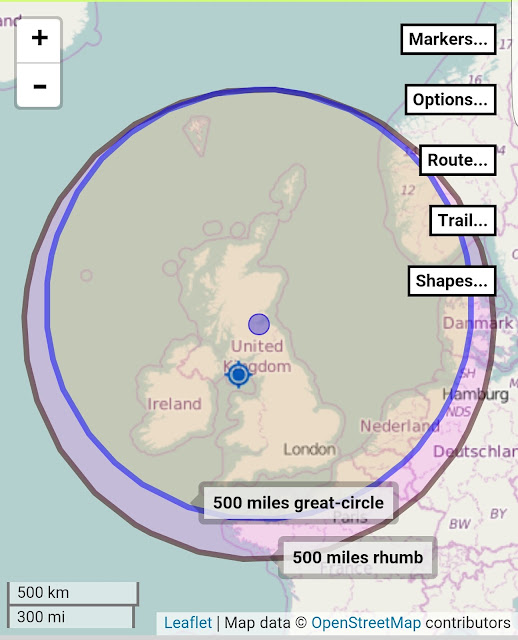Drawing Shapes on Maps
A while ago an image was doing the rounds on social media which showed a circle with radius of 500 miles centred on Leith, thereby depicting the possible search area covered by the Proclaimers in their (rather excellent ) "500 miles" .
As is often the case one sees with shapes drawn on maps, the circle was drawn as a pure geometric circle superimposed on a Mercator map projection. This is of course easy to do, but is misleading: strictly speaking, that pure shape suggests that all the radial lines would be Rhumb-lines (i.e., straight lines drawn on a Mercator projection). Although it looks like a circle, it really isn't: when drawn on the surface of a sphere (or more accurately, an ellipsoid) representing the Earth's 3D geometry, that simple Rhumb-line circle would be distorted. Instead, a circle drawn on the surface of the sphere (or ellipsoid) should be constructed from radial lines which are arcs of Great Circles rather than Rhumb-lines (note: such a circle, constructed from Great Circle arc radii, is actually called a Small Circle). The aforementioned distortion is greater for larger circles: but even at 500 miles radius, it is evident.
The image below illustrates the point. The two "500 mile circles" are depicted: the one constructed from Rhumb-lines (which actually looks like a circle on this Mercator projection map), the other from Great Circles (which is actually distorted on the map, but would look like a circle when viewed on the surface of an ellipsoid). Both are centred on Leith (near Edinburgh, Scotland). Since distances aren't preserved under projection, I have (arbitrarily) set the northern-most point of each circle to be in the same location (at 500 miles along a Great Circle from Leith). All other points on the two shapes are different. In terms of perimeters and areas, the Rhumb-line derived circular shape is larger: perimeter 5,639 km; area 254,3000 sq-km, versus perimeter 5,038 km; area 202,8000 sq-km for the Great Circle derived shape. So, assuming The Proclaimers walk along Great Circles in their quest, they will cover a smaller area of land than if they simply drew a circle on a map and used that to navigate.
#RSMM
I've used this "500 miles" example to demonstrate the (new) Shapes functionality I've just released within my #RSMM (#ReallySimpleMovingMap) web-app.
Here's the #RSMM link containing the "500 miles" example. Click on it to go the #RSMM web-app. From there, you can experiment with lots of different shapes (not just circles!)
Here is a summary of the Shapes functionality within #RSMM:
- Create shapes and display them on the map. Available shapes include:
- point
- line (arbitrary number of vertices)
- circle and circular arc (portion of circle)
- square
- rectangle
- triangle
- polygon (arbitrary number of vertices)
- The shapes can be specified as being constructed from either Great-Circle segments (on a reference Ellipsoid), or from Rhumb-line segments (i.e., straight lines on Mercator projections)
- For convenience, the shape coordinates are initialised via Marker locations, and then can be fine-tuned via edit-boxes
- All visual attributes of the shapes can be customised e.g., line color & opacity, line thickness, fill colour & opacity, etc.
- Save the shapes (individually or in groups) to the FlyLogical Cloud (database) for convenient re-use later (and for sharing with the public if desired)
- Export the shapes (individually or in groups) to KML file format (sent by email) for ease-of-use with KML-supporting apps such as GoogleEarth.
Enjoy!


No comments:
Post a Comment